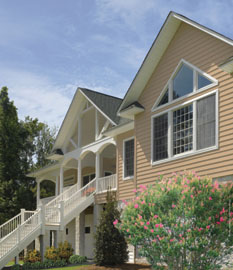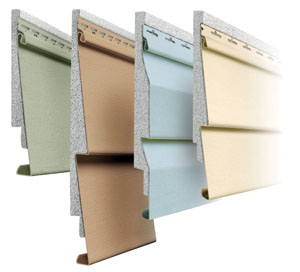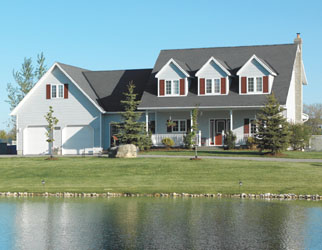As utility costs continue to soar, building materials that save energy and natural resources are growing in demand. According to the National Association of Home Builders (NAHB), 40 percent of homeowners who recently remodeled their home used “green” energy-saving products or materials. And 63 percent of home buyers surveyed said their green purchases were motivated by the lower operating and maintenance costs that come with energy- and resource-efficient homes.
One effective way to improve home energy efficiency is with the installation of insulated siding. These siding products include a thick layer of rigid foam insulation that is fused behind the surface of the siding panel. With a solid, gapless fit, insulated siding can save lots of money in energy costs.
What Makes it Green?
Insulated Siding with Fullback Technology (the full product name of the siding’s expanded polystyrene backing) is an Energy Star-qualified product engineered to satisfy the demands of the U.S. Department of Energy and the EPA. By reducing energy consumption, homeowners not only save money but serve as part of the solution to the nation’s dependence on fossil fuels.
“Insulated siding not only addresses our need to reduce energy consumption, it is a green product throughout its lifecycle,” says Pat Culpepper, president of Progressive Foam Technologies, Inc., which manufactures the rigid foam backing for siding companies. “Our state-of-the-art manufacturing facilities are designed for minimal energy consumption and waste, and the finished product contributes to a healthier home and overall environment.”
According to the manufacturers, once installed, insulated siding can withstand the perils of weather for 50 years without significant degradation. This minimizes the use of ozone-depleting maintenance products like paints, stains and caulk. Plus, the breathable nature of the insulated siding improves indoor air quality by reducing mold and mildew that can grow in the walls of a home.
How Does it Work?
Heating and cooling account for 50 to 70 percent of the energy costs in an average home. An often overlooked aspect of home construction is the fact that as much as 40 percent of heat loss occurs through the wooden wall studs, which are typically not insulated. These wood studs make up 1/4 of the average home’s exterior surface, and insulated siding creates a solid blanket of foam around the home, insulating these otherwise unprotected areas.
Insulated siding offers an average R-value of 3.96, which is more than triple the R-value of any other exterior cladding. When used with fiberglass batting or other conventional materials that are installed between wall studs, the continuous blanket of insulation reduces energy consumption by as much as 20 percent.
De-“Myth”-ifying
One concern sometimes voiced by siding contractors is a fear that the foam backing will have moisture-retention problems. Greg Duplin, VP sales and marketing for Progressive Foam Technologies, assures us this is not the case. “It is human nature to expect foam to wick moisture because it is somewhat spongy,” says Duplin.
“However, this material has been extensively tested, and the assumption that insulated siding contributes to moisture problems is a misconception due to ignorance of the facts. There are literally millions of square feet of insulated siding in the market today, and there has not been a single claim around water or moisture absorption.”
In fact, insulated siding’s unique breathability—three times that of other forms of exterior insulation—allows water vapors to escape the home, which helps reduce moisture that can lead to molds, fungi and bacteria.
A thick layer of rigid foam insualtion is fused behind the surface of the vinyl siding panel.
How Durable is it?
According to the experts at Progressive Foam Technologies, many sidings without rigid foam insulation can absorb the impact of only about 60 PSI before the panels dent or break. When struck by hail, falling tree limbs or other objects, these siding products can crack or deform. However, in tests performed by an independent laboratory, rigid foam insulation increased the impact resistance of the siding up to 320 PSI. That’s an increase of more than 400 percent.
What Else Can it Do?
An additional benefit is that insulated siding is manufactured with an insect-fighting ingredient. This is a patented process to incorporate the EPA-registered additive into the insulation. The ingredient uses boron to deter termites from nesting in the foam, but it remains safe for humans and pets. The foam backing also eliminates the space behind the siding where insects tend to congregate.
Insuplank insulated vinyl siding from Mitten, Inc. is tested to withstand winds up to 200 mph.
Furthermore, homeowners report that insulated siding greatly reduces outside noise and makes their homes quieter. With the home wrapped in a continuous blanket of insulation, it eliminates the rattling sound typical of some siding products.







